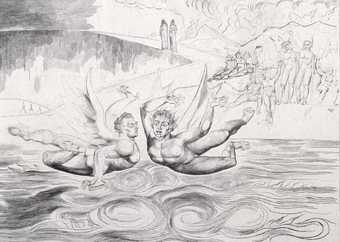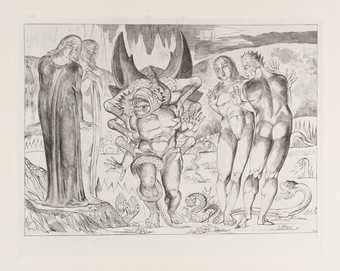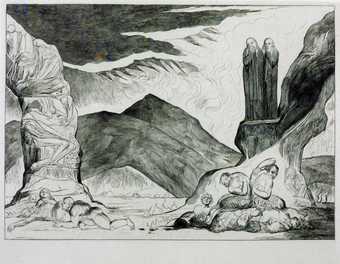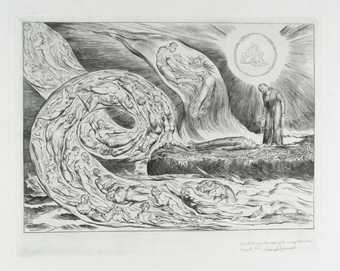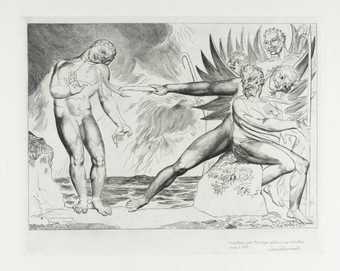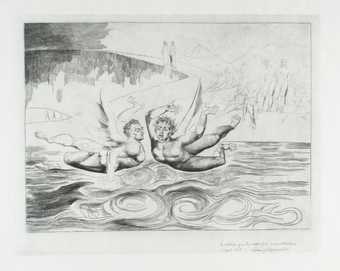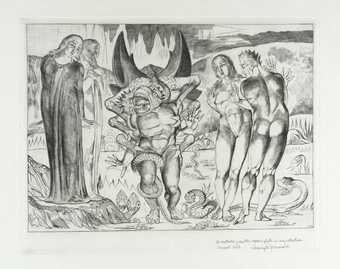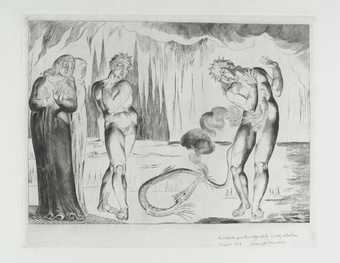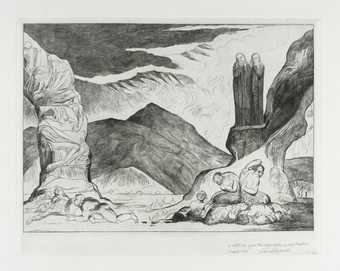
In Tate Britain
Prints and Drawings Room
View by appointment- Artist
- William Blake 1757–1827
- Medium
- Line engraving on paper
- Dimensions
- Image: 241 × 335 mm
- Collection
- Tate
- Acquisition
- Purchased with the assistance of a special grant from the National Gallery and donations from the Art Fund, Lord Duveen and others, and presented through the Art Fund 1919
- Reference
- A00009
Display caption
Gallery label, August 2004
Does this text contain inaccurate information or language that you feel we should improve or change? We would like to hear from you.
Catalogue entry
A00009 [from] Illustrations to Dante's Divine Comedy: Engravings 1826–7/1892
A 00005–11 [A00005-A00011; N03351-N03370; T01950-T01956; complete]
Seven line engravings on india paper laid on drawing paper, each approx. 240×335 (9 1/2×13 1/4)
Purchased with the assistance of a special grant from the National Gallery and donations from the National Art-Collections Fund, Lord Duveen and others, and presented through the National Art-Collections Fund 1919
PROVENANCE John Linnell; his heirs, sold Christie's 15 March 1918 (in 148, with the 102 watercolour illustrations to Dante) £7,665 bt Martin for the donors
LITERATURE Russell Engravings
1912, pp.115–8 no.34; Keynes Bibiliography 1921, pp.182–5 no.56; Keynes Engravings 1950, pp.16–17; Roe 1953, pp.4–6, 41–2, 65, 96, 97, 108, 110, 116–7, 127–8, series repr. pls.10E, 41E, 42E, 51E, 53E, 58E and 65E; Keynes Writings 1957, pp.873, 876–7, 879; Ruthven Todd, Blake's Dante Plates, 1968 (reprinted with additions from Book Collecting & Library Monthly, VI, 1968, pp.164–71, itself based on a letter to The Times Literary Supplement 29 August 1968, p.928); Bentley Blake Records 1969, pp.315–6; Bentley Blake Books 1977, pp.544–6 no.448; Bindman Graphic Works 1978, p.487 nos.647–53, series repr.plus full-size details; Essick Printmaker 1981, pp.78–9, 250–4
This is the first of two sets in the Tate Gallery of prints taken from the original plates. Altogether four printings have been done, two while the plates belonged to the Linnell family and two while they belonged to Lessing J. Rosenwald. In a ‘List of John Linnell Senior's Letters and Papers’ (in the Ivimy Collection) Linnell's son John Linnell Jr wrote that, following a few proofs taken by Blake himself, his father had ‘had India proofs taken (all disposed of)’; the accounts and day books of Dickson & Ross show that this was in 1838. John Linnell Jr goes on to say that after his father's death fifty further copies, in ‘india on drawing paper’, were printed by Holdgate; the draft of a letter from the same writer to Bernard Quaritch of 6 May 1892 (also in the Ivimy Collection) implies that this second printing was about to be made. As all of the 1838 printing was ‘disposed of’ it was presumably one of the later series that was acquired for the Tate Gallery in the Linnell sale of 1918. Of what seem to be Blake's original proofs there is a complete set of one proof for each composition in the British Museum and individual proofs elsewhere. The plates have passed, with the Rosenwald Collection, to the National Gallery of Art, Washington.
The subject of each engraving was identified on a label pasted to the cover of the 1838 issue that reads as follows:
BLAKE'S ILLUSTRATIONS OF DANTE. /Seven Plates, designed and engraved by W. BLAKE, Author of ‘Illustrations of / the Book of Job,’ &c. &c. /Price £2.2s. India Paper./—/ PLATE I./ ... and like a corse fell to the ground./ HELL; Canto v.line 137. / PLATE II./....seiz'd on his arm, / And mangled bore away the sinewy part. / HELL; Canto xxii. line 70. / PLATE III./ .... so turn'd / His talons on his comrade. / HELL; Canto xxii. line 135./ PLATE IV. / ...lo! a serpent with six feet / Springs forth on one, / HELL; Canto xxv. line 45./ PLATE V. / He ey'd the serpent and the serpent him. / HELL; Canto xxv. line 82. / PLATE VI. /... Then two I mark'd, that sat Propp'd gainst each other, /HELL; Canto xxix, line 71. / PLATE VII./ ‘Wherefore dost bruise me?’ weeping he / exclaim'd. /HELL; Canto xxxii.line 79. / CARY'S DANTE.
The first record of Blake working on the engravings comes in a letter by him to Linnell of 2 July 1826, in which he wrote that he was coming to stay with him in Hampstead bringing, ‘besides our necessary change of apparel, Only My Book of Drawings from Dante & one Plate shut up in the Book’. On 25 April 1827 Blake wrote to Linnell to say that ‘I have Proved the Six Plates, & reduced the Fighting devils for the Copper’. Blake's death on 12 August 1827 prevented any further work on the engravings, and ‘The Baffled Devils Fighting’ is noticeably incomplete; Blake might, of course, have intended to work further on the other plates as well.
These engravings were formerly inventoried as nos.3371 i–viii.
A00009 The Serpent Attacking Buoso Donati
Engraving 241×335 (9 1/2×13 3/16); platemark 280×354 (11×13 15/16)
EXHIBITED Tate Gallery 1978 (327, repr.) Inferno XXV, 79–93. For the finished watercolour in the Tate Gallery see N03361.
Published in:
Martin Butlin, William Blake 1757-1827, Tate Gallery Collections, V, London 1990
Explore
- emotions, concepts and ideas(16,416)
-
- emotions and human qualities(5,345)
-
- horror(180)
- universal concepts(6,387)
-
- transformation(186)
- characters(438)
- actions: expressive(2,622)
-
- recoiling(65)
- hand / hands raised(143)
- standing(3,106)
- looking / watching(581)
- man(10,453)
- group(4,227)
- male(959)
- mythical, religious, fictional(260)
-
- Hell(93)
- Judaeo-Christian imagery(856)
-
- Hell(252)
- crime and punishment(431)
-
- thief(17)
You might like
-
William Blake The Circle of the Lustful: Francesca da Rimini (‘The Whirlwind of Lovers’)
1826–7, reprinted 1892 -
William Blake Ciampolo the Barrator Tormented by the Devils
1826–7, reprinted 1892 -
William Blake The Baffled Devils Fighting
1826–7, reprinted 1892 -
William Blake The Six-Footed Serpent Attacking Agnolo Brunelleschi
1826–7, reprinted 1892 -
William Blake The Pit of Disease: The Falsifiers
1826–7, reprinted 1892 -
William Blake Dante Striking against Bocca Degli Abati
1826–7, reprinted 1892 -
William Blake Plutus
1824–7 -
William Blake The Circle of the Lustful: Francesca da Rimini (‘The Whirlwind of Lovers’)
1826–7, reprinted 1968 -
William Blake Ciampolo the Barrator Tormented by the Devils
1826–7, reprinted 1968 -
William Blake The Baffled Devils Fighting
1826–7, reprinted 1968 -
William Blake The Six-Footed Serpent Attacking Agnolo Brunelleschi
1826–7, reprinted 1968 -
William Blake The Serpent Attacking Buoso Donati
1826–7, reprinted 1968 -
William Blake The Pit of Disease: The Falsifiers
1826–7, reprinted 1968 -
William Blake Dante Striking Against Bocca degli Abati
1826–7, reprinted 1968



